
 |
The Enterprise Mission |
|---|
CONTACT INFORMATION:
MICHAEL BARA lunaranomalies@uswest.net
(Note - I am not able to respond to all e-mails, but
I will read them -- MB)
RICHARD C. HOAGLAND - The Enterprise Mission
P. O. Box 1180
Tijeras NM 87059
FAX - (505) 286-6130
© 2000 THE ENTERPRISE MISSION
Tetrahedrons, Faces on Mars, Exploding Planets, Hyperdimensional
Physics --
and Tom Corbett, Space Cadet?!
Or
What Did They Know, and When Did They Know it?
Occasionally, something comes across our desks that is so obvious, so undeniable, so conspiratorial, that we just can't help but rub our critics noses in it. Just like the Hyperdimensional "Millennium Ball" dropped in New York's Times Square on New Year's Eve past, or Carl Sagan's otherwise inexplicable inclusion of footage of Richard C. Hoagland in the Viking portion of his televised authorized biography, we have found numerous examples of blatant "messages" being sent by those "in the know.".
Yet another case in point -- Tom Corbett, Space Cadet.
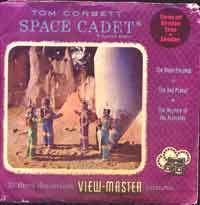
In 1992, an architect in Atlanta, Ga., specializing in sacred geometry, presented a series of View Master slides to Enterprise principal investigator Richard C. Hoagland. This architect was not only a specialist in "block walls and concrete," but was also a member of certain secret society -- the Masons. The slides he provided depicted a space adventure through the solar system, from the Moon to Mars and beyond to the Asteroid Belt. In the story, an ancient civilization was found by "asteroid miners" to have once existed on a former planet between Mars and Jupiter. This civilization left behind a calling card: a series of "tetrahedral" pyramids with "magical" properties -- like anti-gravity --discovered in the Asteroid Belt and on the Moon.
Sound familiar? It should. But the source is even more intriguing.
After receiving this data more than eight years ago, we began to re-assess our perspective on just how long "they" may have known about Cydonia. Enterprise principal investigator Richard C. Hoagland then spent the better part of the next decade -- and several tens of thousands of dollars -- tracking down the principals behind the creation of this particular product and establishing what connections, if any, there were to the various players behind the scenes at NASA. Eventually, as we developed our "stellar ritual alignment" model and it's connections to the belief systems of various "secret societies" involved at the highest levels of our space program, we became even more suspicious that somebody may have had a pre-conceived idea that there was something "down there" at Cydonia (see below). We then began to dig into the background of the Tom Corbett universe, and some even more interesting linkages began to appear.
Based on Robert Heinlein's juvenile novel SPACE CADET published in 1948, "Tom Corbett, Space Cadet" was something of a multimedia phenomenon from 1950-55. Books, comics, and all manner of radio and TV versions were produced in great abundance during this period. This futuristic property was used to educate and encourage young minds to get interested in space travel and science.
Now however, it appears that it was used for something more -- to educate and encourage young minds about the reality of the Exploding Planet Hypothesis, the Face on Mars, artifacts on the Moon, and Hyperdimensional Physics. For there, buried in a series of View Master slides created in 1955, four years before "Brookings," is virtually the entire history of the Cydonia investigation in one form or another. Given that that report called for a process of "conditioning" the general public in advance of announcing that "artifacts" had been found in the solar system, and this blatant reference is exactly just such a tool, the question is begged:
What did they know? And when, exactly, did they know it?
Before you scoff and dismiss the notion, as our critics invariably do without offering an alternative scenario other than a pejorative out of hand dismissal, consider this: NASA and the American rocketry program has had a long history of partnering with Hollywood to produce programming related to the space program. One such film was recently re-shown on the Disney Channel. Entitled "Man and the Moon." The science adviser of the film was Dr. Werner Von Braun, a close friend of Willy Ley and Walt Disney. (Thanks to Rick L. Sterling for this info).

In the film, Von Braun discusses his concepts for how a manned reconnaissance of the Moon might be handled in the near future. He tells the audience, in extensive detail, how such a mission would be designed and carried out. Using a model of his rocket concept, Von Braun sets up the following dramatization of man's first mission to the Moon.
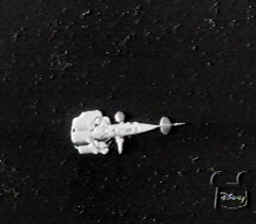
In that dramatization, Von Braun's rocket takes five days to get to the Moon with a chance for one pass around the "dark side" before returning to Earth. The dramatization is like a played like mini-movie but clearly a mini-movie with Von Braun's indelible stamp on it.

As the ship reaches the Moon, the crew begins to launch flares to illuminate the darkened portions of the Lunar landscape. The film does a remarkable job of accurately depicting the Moon's surface, until a dramatic event takes place. As the ship is flying along in it's single orbit taking readings, a crewman suddenly announces that he has a high radiation reading at "33 degrees." A radar operator then announces that he has an unusual formation coming up in front of them, and a flare is launched immediately.

When it detonates, the flare reveals the unmistakable, geometric outline of an installation, presumably an alien base, beneath them on the far side of the Moon! There is no question that this formation is completely different than anything we have seen in any of the other views of the Moon to this point, and no question that it is artificial.
So what is the reaction to this sight by the astronauts? Absolutely nothing! Not a word is spoken about it in the dramatization or at any point later in the show. Von Braun simply inserted it without comment. One possible implication of this (in regards to the dramatization) is that the astronauts were required to keep quiet about what they saw. A sort of "pre-Brookings" Brookings policy in action!
This is really not surprising. Von Braun, Ley, and Robert Heinlien all had close ties to not only the entertainment industry and the space program, but to each other through various associations. Ley among other things, was partly responsible for helping Von Braun get into the US under Project Paperclip. Solarguard, a web site dedicated to the Tom Corbett universe, also credits Ley and Heinlein with being science advisors to the Tom Corbett series, just as Von Braun was science advisor to "Man and the Moon."
Ley was also good friends with a science and science fiction writer named Arthur C. Clarke. Clarke, among many other accomplishments, is best known for his creation (along with Stanley Kubrick) of the ultimate cinematic expression of "Hyperdimensional Physics."
2001 -- A Space Odyssey.

In this ground breaking and universally acclaimed film, based on Clarke's short story "The Sentinel," Clarke and Kubrick explore the impact on humanity of the first proof of the existence of extraterrestrial life -- in the form of an artifact found in the crater Tycho on the Moon. The parallels between Clarke's "fictional" story and the real discovery of artifacts at Cydonia are stunning. At the time Monuments was written, Enterprise principal investigator Richard C. Hoagland had assumed that these connections were merely coincidental, and that his long-time friend was merely "exceptionally prescient." Now of course, we're a bit less naive. Sadly, Kubrick and Clarke's "take" on the prospect of ETs in the Solar System is straight out of "Brookings." In the film, not only is this critical information deliberately withheld from the public (and the rest of the "space agency!"), but that agency is willing to go to any lengths, including sacrificing the crew of the mission sent to investigate, to keep "The Secret." Ultimately, the story takes the crew of the Discovery to Jupiter, and the one surviving member of the mission embarks to investigate another artifact in orbit around Jupiter. The astronaut is ultimately swept away in a sort of "Hyperdimensional Stargate."
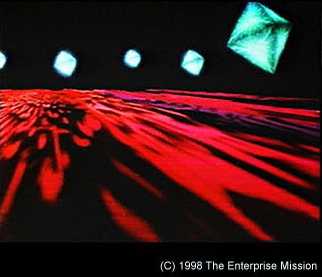
This film is certainly in keeping with the general theme of Kubrick's work. From "Paths of Glory" to "Sparticus" to "Full Metal Jacket" to "Eyes Wide Shut," Kubrick's work has had one universal axiom -- power structures are inherently abusive of the power they possess. In the case of "2001" this plays itself out in the central thesis which seems uncomfortably close to our own Cydonia experience -- "if they find, they will hide it."
But it was Clarke who defined the mechanism by which the "Hyperdimensional" transition would be made, through the central symbol of the film, The Monolith. As we have shown previously, Clarke's original idea for the Monolith is that it would be a massive black tetrahedron. However, he eventually decided that such a form would be "too obvious" and instead settled on the rectangular shape. Yet, he was still careful to encode the basic concepts of the tetrahedron in the proportions of the Monolith -- 1 x 4 x 9, the squares of 1,2,3, the ratios of inscribed/circumscribed tetrahedra to their respective spheres (planets).
So the Monolith itself (by Clarke's own admission) is nothing more than a not so thinly disguised "Cydonian" tetrahedron!
In essence, we have alleged that "2001" was nothing less than an outgrowth of the same "Brookings" mentality that the film denounces. This same pattern of "timed release aspirin" has continued to find its way into many modern TV programs and films, including the recent "X-files" and "Millennium" shows created by Chris Carter. In making such claims, we have been described as "fanciful" or making too much out of "coincidences." Yet each of these cases, Von Braun's film, "2001" and even the Heinlien/Ley "Corbett" slides make essentially the same case. Artifacts abound in the Solar System. And if they find them, they will hide them.
However, as you will see, the Tom Corbett case is on an entirely new level.
A bit of setup is required here. As many of you know, the central thesis of the Hoagland/Torun relationship model of Cydonia is that the arrangement of anomalous objects there, like the Cliff, Tholus, D&M Pyramid and the Face, among others, are designed to commemorate the constants of tetrahedral geometry. And further, that this tetrahedral geometry, when applied to observational physics, predicts the presence of higher dimensional energies in our common "3-space" universe. Inherent in this "Hyperdimensional Physics" is not only the control of gravitational forces, but also the promise of free and unlimited amounts of energy.
We have also begun to look into the Moon, and discovered the remnants of an equally vast and advanced civilization there, marked by this same tetrahedral motif.

And all of it, draped behind the curtain of a secret, separate space program built around the myths and legends of ancient Egypt.
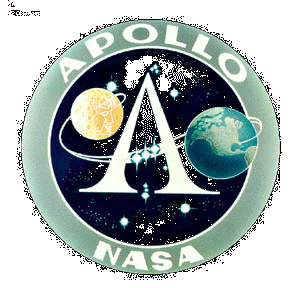
In recent years, a new perspective has found it's way into this model. Dr. Tom Van Flandern, a leading academic proponent of the Cydonia artificiality hypothesis (though not necessarily the tetrahedral model), has been promoting the idea that the asteroid belt may be the remnants of an exploded planet between Mars and Jupiter. He asserts that Mars was once a moon of this destroyed "Planet V," and that the Cydonia was a base of some kind for the original inhabitants of that shattered world.
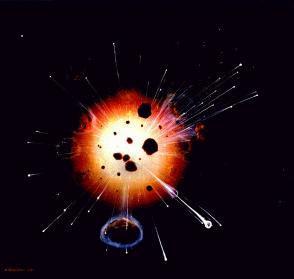
One of the key bases for rejecting Van Flandern's ideas out of hand is the assertion that since modern science knows of "no mechanism by which planets can explode," there must be some other explanation for the asteroid belt in the "Bode orbit" between Mars and Jupiter. This sort of intellectually vacuous reasoning is frequently used by the scientific community to discredit ideas it does not like or which threaten established hypotheses (see The Nemesis Affair, by Dr. David M. Raup. A history of the debunking attacks against the idea that the Dinosaurs were extinguished by an asteroid impact). Of course, "Hyperdimensional Physics" does provide just such a mechanism, even though the notion that artificial ruins on Mars can teach us an entirely new theory of physics is even more frightening to the established order than exploding planets and is therefore also consistently ignored.
In any event, keep all of these recent ideas in mind as we turn the clock back 45 years and ask the question above --
-- "What did they know, and when, exactly, did they know
it?"
The story begins with the discovery of an ancient artifact with magical properties.

Found by a miner in the Asteroid Belt, this tetrahedral pyramid is inscribed with Egyptian style hieroglyphs and floats 2 inches above any surface upon which it is placed. Earth's best scientists are at a loss to explain how the pyramid is defying gravity. Captain Strong, (seated, with pipe) explains that Earth's scientists think that the asteroids are remnants of an exploded planet between Mars and Jupiter, and that this tetrahedral artifact is a piece of technology from an advanced civilization which flourished there millions of years ago. The Space Cadet team is assigned to investigate, and they decide to start on the Moon, where many years before a similar tetrahedral pyramid was found on the "dark side." So, off to the Moon they go in their rocket ship, the "Polaris."
Now, to those of you who have been paying attention, the name "Polaris"
will ring a bell. Since Hyperdimensional Physics and tetrahedrons are intimately
connected with rotation and the riddle
of precession, the choice of naming the spaceship in the series after
the Polar star would seem, well, interesting.
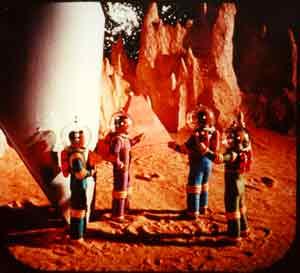
Back to the story. Upon arriving on the Moon, our crew locates the mysterious pyramid and notices that it is missing its capstone. Deducing that the pyramid found in the Asteroid Belt might be the missing capstone, they place it upon the stone tetrahedral pyramid. The capstone seems to jump out of Tom's hand and lock in place.
As it does so, the now reassembled tetrahedral pyramid turns transparent and reveals a globe of the planet Mars contained inside. There is a red mark on the globe, indicating a signpost of some type. This marker, curiously, is tangential to a key "tetrahedral lattitude" -- 19.5 degrees. Deciding they are supposed to follow the lead, the crew heads back to the ship to head to Mars to investigate.
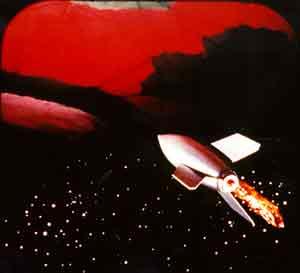
Meanwhile, a rival group to the Solar Guard has discovered that the crew of the "Polaris" are looking for an ancient artifact that can give them (and Earth) advanced anti-gravity technology. So, spies are dispatched to assure that Interplanetary Crime gets "the Secret" first.
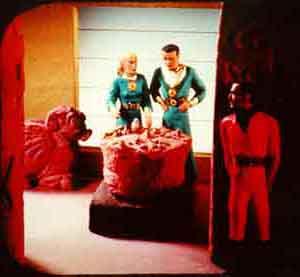
Upon arriving at the Martian colony of Marsport, Tom meets with Dr. Joan Dale, and explains that the globe they found indicates there are ruins on Mars at the junctions of canals 7 and 19 (two "tetrahedral numbers," by the way). Dr. Dale shows him a partial map that was discovered years before. She tells him it is of an archeological site near the canal junctions where there was once a pyramid over 1,000 feet high (shades of Cydonia, anyone!) -- but that is now in ruin. As they make plans to head there, an Interplanetary Crime spy decides to follow them.
Upon arriving at the site, amid Egyptian style obelisks and under a terraformed blue Martian sky, Tom and Dr. Dale discover yet another ancient artifact. This time it is a sculpted Face of a feline-like creature.
Between the paws of the creature, they discover an image of a shattered planet whose fragments form into a belt of Asteroids. Below that is a strange numbering system. Taking this to be an indication that they need to go back to the Asteroid Belt where the original capstone was found, they return to Marsport to try and determine what the numbers mean.
Using the massive Solarguard mainframe computer, Dr. Dale figures out that the numbers are coordinates for an asteroid discovered in 1993 and named XKG-385fr. However, agents for the Interplanetary Crime unit kidnap her and head off for the asteroid to get the secret to anti-gravity devices.

In hot pursuit, Tom and the Polaris follow the IC ship and discover that they have landed on a small asteroid. Landing, they find an entrance to the interior of the asteroid.

Upon entering, a fist fight ensues and the Spaceguard boys win the day. They discover some projection equipment and watch and learn about the race that built this asteroid as a "time tomb." Eventually, they take their discoveries back to Earth and conduct experiments on anti-gravity technology, in secret.
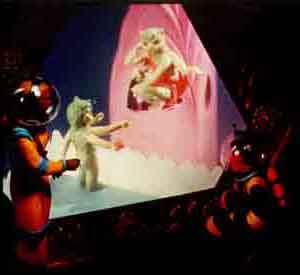
The neat thing about this is that it doesn't require even a minimal degree of projection or filling in of the blanks on our part. We have surmised that an ancient race from an exploded planet between Mars and Jupiter left behind ruins on the Moon and Mars. Their advanced technology was centered around the principles of tetrahedral physics. We have suggested that behind the scenes, rival groups are fighting it out for control of this advanced, ancient knowledge. And we have even suggested that the Face on Mars has decidedly feline characteristics.
For many years, Enterprise principal investigator Richard C. Hoagland has argued that the Eastern side of the Face, the side we can't seem to get a clear picture of, has a distinctly feline appearance. This led him to speculate during his historic U.N. Presentation (in early 1992) that the structure might in fact represent a sort of "man/feline hybrid," as in the Great Sphinx of Egypt. Remarkably, only a few months later, Hoagland would be presented with startling "confirmation" of this controversial hypothesis: in the form of the incredibly predictive 1950's Tom Corbett View Master slides. Six years later, there was nothing in the new MGS image of the Face in 1998 to discourage this view. In fact, we discovered that the Face contains two clearly defined nostrils, which only added to its distinctly feline appearance.
And all of this is contained in this "Tom Corbett, Space Cadet" View Master presentation.
It is hard to imagine how any rational person can deny the linkages here. The simple existence of these reels is proof in of itself that the makers of this story had some inside prior knowledge of what was at Cydonia. But when you factor in the presence of Willy Ley, Werner Von Braun's personal friend and certainly a man likely to have shared Von Braun's bizarre occult belief system (through the SS), it gets almost comical to try and explain away the significance of this find. Von Braun, for his part, was deeply involved in many aspects of the tetrahedral NASA/Masonic rituals we have documented.
That all of this came down even before Brookings, before the official line that a populace should be conditioned prior to the release of evidence of ruins in the solar system, is even more intriguing. NASA itself was still several years from its own birth, and it would seem that there was already a Brookings-like conditioning policy in place. The question is what was the motivating factor here? Could there perhaps have been a prior discovery of information relating to Cydonia? Perhaps as an outgrowth of data obtained from Roswell? Just how could Von Braun and his colleagues have known what they already obviously knew? Whatever the source, this speculation must remain secondary to the now self-evident fact.
They knew.
Perhaps this explains why we had yet another of those curious Egyptian/Tetrahedral alignments at Cydonia the moment that first image of the Face was captured by Viking 1. They had been planning the opportunity for decades.
Given the obvious weight of all this, the only tactic our critics are left with at this point is to simply deny. Certainly there cannot be a rational explanation, other than the one we have offered, to explain away these "coincidences." Yet, they can still retreat behind this wall of denial and hope that everybody just forgets about this in a few months.
Except they've got another problem.
We found the asteroid. And the entrance.

The asteroid is none other than 433 Eros, perhaps the single most important asteroid ever discovered. Found in 1898, Eros, because of its unique orbit and size, was eventually used to calculate the distance of the Astronomical Unit. For more than a century, it was the guide stone by which astronomers measured solar distances. The 33 km by 13 km potato-shaped rock has an orbit that crosses that of Mars, putting it in a special category of "Amor" class asteroids (asteroids that cross the orbit of Mars but not Earth). It is also the subject of a special NASA mission. The NEAR spacecraft is currently orbiting the asteroid and snapping dozens of images a day. On February 14th of this year (Valentine's Day) the first close up images of Eros came back to Earth and revealed a heart shaped crater near the South pole. And even though Eros was discovered more than a century ago, the go ahead for the NEAR mission was in the "Corbett" year of 1993. While NASA has admitted that they planned the February 14th rendezvous, we are expected to assume that the heart shaped crater is just another lucky coincidence and dismiss it.
Yet, when we got beyond that series of unlikely events and actually looked closely at some of the images, we discovered a feature that only makes sense in the context of this new Tom Corbett information. There, on Eros, is a what appears to be a regular, highly geometric structure, very similar to the one depicted in the View Master slides! You can see for yourself: go to the NEAR Website and search the official May 3rd archive for NEAR Frame 20000503.
A portion of the official NEAR Mission caption for this image also seems worthy of reproduction here ...
Uh ... this image just happened to be taken from how many miles above the Eros surface ..? And the official NASA caption describes this highly regular, highly polished, multi-leveled and multi-faceted geometric object as ...: a 148-foot "rectangular boulder?""The imager will take pictures of the entire surface of Eros that capture features as small as 4 meters (13 feet) across. This particular image, taken from an orbital altitude of 53 kilometers (33 miles), shows a scene about 1.8 kilometers (1.1 miles) across. Numerous craters and boulders as small as 8 meters (26 feet) across dot the landscape. The large, rectangular boulder at the upper right is 45 meters (148 feet) across."
But it gets even better. In an interview with CNN, NEAR project scientist Andrew Cheng as much as admitted that the exploded planet Hypothesis was the source for Eros:
This means that Eros meets all the criteria for the "Hall of Records" asteroid depicted in Corbett View Master reel. And it is obviously an object that has been known about for a long time before the Corbett reels were produced."Collected by the Near Earth Rendezvous spacecraft, some of the images show signs of geological layering, which suggests that Eros was once part of a much larger celestial body, said Andrew Cheng, a NEAR project scientist. "A plausible way that it (layering) happened is if Eros was once part of a larger body," Cheng said, "probably a planet-sized body that once broke up."
So now we know which asteroid to find the "Hall of Records" on, and precisely where the entrance is. The next logical step would seem to be a robotic lander or manned mission to crack the seal and complete the cycle that Von Braun and his friend Willy Ley started 45 years ago. So, how about it NASA?
Wanna take a ride?
The Enterprise Mission
P. O. Box 1180
Tijeras NM 87059
FAX (505) 286-6130